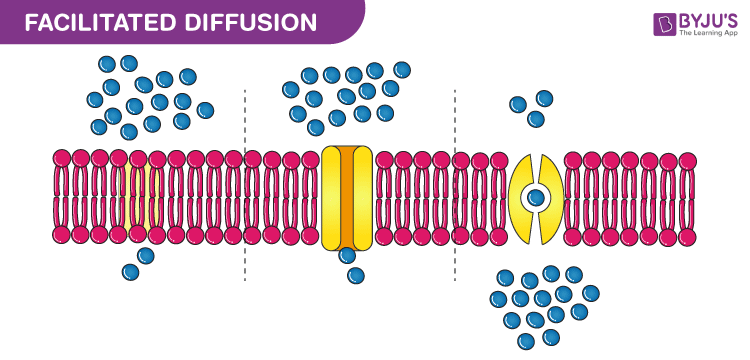“Facilitated diffusion is a type of diffusion in which the molecules move from the region of higher concentration to the region of lower concentration assisted by a carrier.”

Facilitated Diffusion
What is Facilitated Diffusion?
Facilitated diffusion is the passive movement of molecules along the concentration gradient. It is a selective process, i.e., the membrane allows only selective molecules and ions to pass through it. It, however, prevents other molecules from passing through the membrane. The electric charge and pH helps in the diffusion across the membrane.
In living systems, the lipid based membrane creates compartments which allow the transport of a selective concentration of water-soluble substances. The ions, small molecules, proteins, and other solutes have different concentration across the membranes. Hydrophilic, polar or charged molecules cannot cross the membrane.
Recommended Video:

Factors Affecting Facilitated Diffusion
Brownian motion is the force behind the diffusion of fluids. The main factors affecting the process of facilitated diffusion are:
-
Temperature- As the temperature increases, the movement of the molecules increases due to an increase in energy.
-
Concentration- The movement of the molecules takes place from the region of higher concentration to lower concentration.
-
Diffusion Distance- The diffusion rate is faster through smaller distance than through the larger distance. For eg., gas diffuses much faster through a thin wall than through a thick wall.
-
Size of the molecules- The smaller molecules are lighter and hence diffuse faster than the larger molecules.
Importance of Facilitated Diffusion
Not every molecule can cross the cell membranes. The molecules should be small and non-polar to traverse the membrane. For eg., glucose is a large molecule that cannot diffuse across the cell membrane. Ions like sodium, potassium, and calcium are charged and are repelled by the cell membrane. Amino acids and nucleic acids are polar and too large to cross the cell membrane. Also, the water movement across the membrane in bulk is difficult at times.
To facilitate these transfer of substances across the membrane, certain integral membrane proteins or the transmembrane proteins are required. They are channel proteins and carrier proteins.
Transmembrane Proteins
Transmembrane proteins are the proteins present in the cell membrane that facilitate the movement of certain molecules across the membrane. There are certain channel proteins and carrier proteins that accelerate the transport process.
-
Channel Proteins: These help in the entry and exit of substances in the cell. There are two types of channel proteins, open channel proteins, and gated channel proteins. Open channel proteins create a pore in the cell membrane and allow the charged molecules to pass through. The gated channel proteins are either closed or open and regulate the entry and exit of substances.
-
Carrier Proteins: These are present on the cell membrane. They carry the molecules, change the confirmation of the molecules and release the molecules to the other side. Temperature and saturation affect the carrier proteins.
There are certain transmembrane proteins that help in the movement of solutes and ions.
Examples of Facilitated Diffusion
Following are the important examples of facilitated diffusion:
Glucose Transporter
These facilitate the transport of glucose across the plasma membrane. These are present in the plasma membrane that binds the glucose molecules and transports them across the lipid bilayer.
The glucose transporters are of two types- sodium-glucose cotransporters which are present in the small intestine and renal tubules and are responsible for the glucose transport against the concentration gradient, and the facilitative glucose transporters which are responsible for the bidirectional movement of glucose molecules across the plasma membrane.
Aquaporins
These proteins facilitate the transport of water across the lipid bilayer. If the proteins forming aquaporins are mutated, it might result in diseases such as diabetes insipidus.
Ion Channels
These are transmembrane proteins that allow the selective transport of ions and solutes across the plasma membrane. These ionic pumps maintain the concentration of the extracellular fluid different from that of the cytosol.
When an excess of sodium ions are present in the extracellular region and excess of potassium ions are present inside the cell, a resting potential is obtained. With a small voltage change, the sodium ion channels open and the sodium ions rapidly enter into the cell. The potassium ion channels also open and the ions move out of the cell.
For more information on Facilitated Diffusion, its importance, examples and factors affecting facilitated diffusion, keep visiting BYJU’S Biology website or download the BYJU’S app for further reference.
Related Links
| Passive Transport | Transportation in Plants |
| Active Transport | Diffusion |

Comments